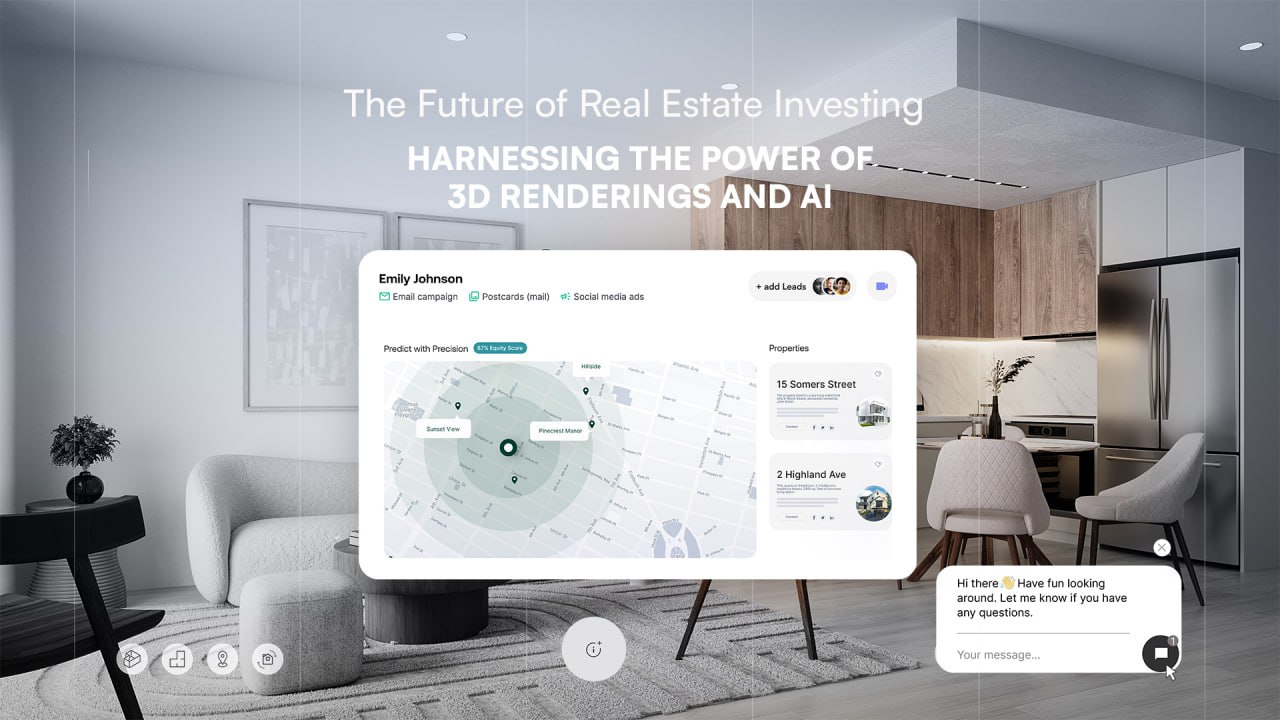The Future of Real Estate Investing: Harnessing the Power of 3D Renderings and AI

Introduction
The world of real estate investing is undergoing a dramatic transformation, driven by the rapid advancements in technology. Two of the most significant game-changers in this industry are 3D renderings and artificial intelligence (AI). These cutting-edge tools are empowering investors to make more informed decisions, visualize opportunities like never before, and streamline their investment processes. In this article, we’ll dive deep into how 3D renderings and AI.
Enhancing Visualization with 3D Renderings
3D renderings are digital representations of properties that provide a highly detailed, immersive view of a space. These renderings are created using specialized software that allows designers to input precise measurements, materials, and textures to generate a photorealistic image. The process involves modeling the property in 3D, applying textures and lighting, and then rendering the final image or animation.
One of the most significant advantages of 3D renderings for real estate investors is the ability to visualize potential renovations, property developments, or construction projects. With before-and-after scenarios, investors can see exactly how a property will look after proposed changes, helping them make more informed decisions and reduce the risk of unexpected outcomes.
Tip: To take visualization a step further, consider using virtual reality (VR) alongside 3D renderings. VR allows investors to immerse themselves in a property, experiencing it as if they were physically present. This can be particularly useful for remote investors or those considering multiple properties.
Example: An investor was considering purchasing a run-down apartment building with the intention of renovating it into high-end condos. By using 3D renderings, the investor was able to see how the property would look after the proposed renovations, including the reconfiguration of the floor plan, the addition of modern finishes, and the creation of attractive common areas. This visualization helped the investor secure financing and ultimately transform the dilapidated property into a highly profitable luxury development.
Leveraging AI for Smart Investing
Artificial intelligence is another technology that is making significant waves in the real estate industry. AI refers to computer systems that can perform tasks that typically require human intelligence, such as learning, problem-solving, and pattern recognition. In real estate investing, AI is primarily used for predictive analytics and machine learning.
Tactic: One of the most powerful applications of AI in real estate investing is its ability to analyze vast amounts of historical data and current market trends to forecast property values and investment risks. By inputting data such as property features, location, economic indicators, and demographic trends, AI algorithms can identify patterns and make predictions about future market conditions.
Trick: AI can also be used to automate many of the tedious and time-consuming tasks associated with real estate investing, such as data collection and analysis. By using AI tools to handle these mundane tasks, investors can free up their time to focus on more strategic decisions, such as property selection and portfolio management.
Deep Dive into PropertyPulse.AI
http://PropertyPulse.AI is a cutting-edge platform that harnesses the power of AI to provide real estate investors with unparalleled insights and predictive analytics. The platform uses machine learning algorithms to analyze a wide range of data points, including property characteristics, market trends, and consumer behavior, to identify high-potential investment opportunities.
Strategy: One of the key features of PropertyPulse.AI is its ability to identify emerging markets or undervalued properties. By analyzing data such as population growth, job market trends, and infrastructure developments, the platform can pinpoint areas that are poised for significant appreciation. This allows investors to get in on the ground floor of up-and-coming neighborhoods, maximizing their potential returns.
Example: An investor was considering purchasing a rental property in a city they were unfamiliar with. By using PropertyPulse.AI , the investor was able to identify a neighborhood that was experiencing significant job growth and infrastructure investment, indicating strong potential for rental demand and property value appreciation. The investor purchased a property in this neighborhood and, within two years, saw a 20% increase in rental income and a 30% increase in property value.
Synergizing 3D Renderings with AI Analytics
While 3D renderings and AI are powerful tools on their own, the true magic happens when they are combined. By integrating 3D visualization with AI’s predictive insights, investors can gain a holistic view of investment opportunities that takes into account both the physical characteristics of a property and the market forces that will shape its future value.
Suggestion: When evaluating a potential investment property, use 3D renderings to visualize the property’s current state and potential renovations, and then use AI analytics to forecast the property’s future value based on market trends and comparable properties. This combination of visual and data-driven insights will give you a more complete picture of the investment opportunity and help you make a more informed decision.
Tip: The combination of 3D renderings and AI analytics can also be a powerful tool for presenting investment proposals to stakeholders or clients. By using 3D visualizations to showcase the potential of a property and AI-driven data to support your investment thesis, you can create a compelling case for why the investment is a smart choice.
Practical Case Studies
To illustrate the power of combining 3D renderings and AI analytics, let’s look at a few real-world case studies.
Case Study 1: A real estate investment firm was considering acquiring a portfolio of outdated office buildings with the intention of converting them into modern, flexible workspaces. By using 3D renderings to visualize the proposed renovations and PropertyPulse.AI ‘s predictive analytics to forecast demand for flexible office space in the area, the firm was able to secure financing and successfully reposition the properties, resulting in a 25% return on investment within 18 months.
Case Study 2: An individual investor was looking to purchase their first rental property but was unsure of which market to invest in. By using PropertyPulse.AI ‘s market analysis tools, the investor identified a city with strong population growth, a diverse job market, and affordable property prices. The investor then used 3D renderings to evaluate potential properties remotely, ultimately purchasing a property that generated a stable rental income and appreciated in value by 15% in the first year.
Tactic: When analyzing these case studies, focus on extracting actionable insights and best practices that you can apply to your own investment strategy. Look for patterns in how the investors used 3D renderings and AI analytics to make informed decisions, and consider how you can adapt these approaches to your specific goals and resources.
Overcoming Challenges
While 3D renderings and AI offer significant benefits to real estate investors, adopting these technologies can come with some challenges. Some common obstacles include the cost of software and tools, the learning curve associated with new technology, and the need for high-quality data to fuel AI analytics.
Trick: For small-scale investors who may not have the resources to invest in expensive software or custom AI solutions, there are still ways to leverage these technologies. Many 3D rendering software providers offer free trials or low-cost subscription plans that can be a good way to get started. Additionally, there are open-source AI tools and public data sources that investors can use to begin incorporating predictive analytics into their decision-making process.
Looking Ahead
As technology continues to advance at a rapid pace, it’s clear that 3D renderings and AI will play an increasingly important role in real estate investing. In the coming years, we can expect to see even more sophisticated tools and platforms emerge, offering investors even greater insights and capabilities.
Suggestion: To stay ahead of the curve in this tech-driven investment landscape, it’s essential to cultivate a mindset of continuous learning and adaptation. Make a habit of staying up-to-date with the latest trends and tools in real estate technology, and be willing to experiment with new approaches to visualizing and analyzing investment opportunities.
Conclusion
The integration of 3D renderings and AI in real estate investing represents a seismic shift in the way investors evaluate and execute on opportunities. By harnessing the power of these technologies, investors can gain a competitive edge, make more informed decisions, and ultimately achieve greater success in their real estate ventures.
Through platforms like PropertyPulse.AI , investors can access cutting-edge predictive analytics and data-driven insights that were once out of reach. Combined with the immersive visualization capabilities of 3D renderings, these tools offer a powerful toolkit for navigating the complex world of real estate investing.
As we’ve seen through practical case studies and real-world examples, the synergy of 3D renderings and AI is already delivering tangible results for investors across a range of strategies and markets. By understanding how to effectively leverage these technologies, investors can position themselves for success in an increasingly competitive and data-driven industry.
If you’re a real estate investor looking to take your strategy to the next level, now is the time to start exploring the potential of 3D renderings and AI. Whether you’re a seasoned pro or just starting out, incorporating these tools into your decision-making process can help you identify high-potential opportunities, mitigate risk, and achieve your investment goals.
To get started, consider experimenting with 3D rendering software to visualize potential investment properties and renovations. Many software providers offer free trials or low-cost plans that can be a good way to get a feel for the technology and its capabilities.
By embracing the power of 3D renderings and AI, you’ll be well-positioned to thrive in the new era of real estate investing and achieve your most ambitious goals. So don’t wait – start exploring these game-changing technologies today and take your investment strategy to new heights!
Additional Services
Take Your Marketing Even Further






Additional Features at no cost
Part of any package












